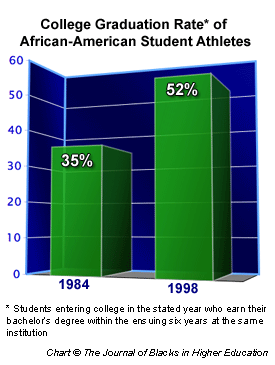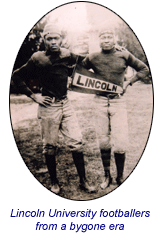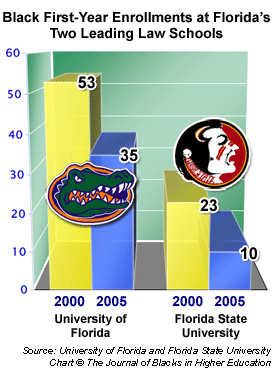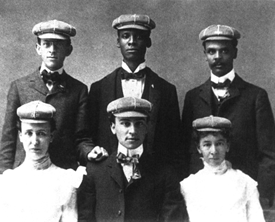Top Universities Report Good Results in Recruiting Black Students
Several of the nation’s leading colleges and universities have reported impressive successes in their efforts to increase racial diversity in their entering classes. Here is a sampling of statistics on the number and percentage of blacks among students accepted at some of our most prestigious institutions of higher education.
• Blacks were 9.6 percent of the 2,150 students admitted to Dartmouth this spring. This is equal to the black percentage of accepted students in 2005.
• At Harvard University, blacks were 10.5 percent of all students admitted. This equaled last year’s record high percentage.
• At Johns Hopkins University, blacks were 9 percent of the 3,232 students offered admission. In 2005 blacks were 8.8 percent of all students accepted for admission, but a low black student yield resulted in a freshman class that was 6.3 percent black.
  |

“Many black students, especially those with public school educations, are even now penalized by their poor grades on standardized tests. Students from schools with limited resources should be judged more on how well they have learned what they have actually been taught and not on what others have learned by virtue of greater exposure to good teaching and a better curriculum.”
— LaSalle D. Lefall Jr., Charles Drew Professor of Surgery at Howard University, in No Boundaries: A Cancer Surgeon’s Odyssey (Howard University Press)
|
Leading Law Schools That Show the Largest Increases in Black Enrollments
In 2005 there were 1,719 black students enrolled at the nation’s 25 highest-ranked law schools. They made up 7.4 percent of all students at these 25 law schools. Blacks were 12.3 percent of all students at the law school at Vanderbilt University, the highest percentage among the leading law schools. Yet, at the University of Minnesota, only 2.2 percent of the law students were black.
 Since 1999 the number and percentage of black students at our nation’s leading law schools have not changed significantly. But individual schools have made considerable progress. Overall, 12 of the top 25 law schools have shown an increase in the percentage of blacks in their student bodies. Thirteen of the 25 leading law schools have seen a drop in black enrollments. Since 1999 the number and percentage of black students at our nation’s leading law schools have not changed significantly. But individual schools have made considerable progress. Overall, 12 of the top 25 law schools have shown an increase in the percentage of blacks in their student bodies. Thirteen of the 25 leading law schools have seen a drop in black enrollments.
By far the most significant increase has been at the law school of Washington and Lee University in Lexington, Virginia. In 1999 only 3.8 percent of the students at the Washington and Lee University law school were black. By 2005 the percentage of blacks in the student body increased to 9 percent.
Other law schools showing at least a two percentage point increase in black enrollments since 1999 are Notre Dame, New York University, the University of Chicago, and Washington University.
The largest decline in black enrollments at a leading law school was at the University of Southern California. There, blacks were 11.8 percent of all law school students in 1999. In 2005 black law school enrollments dropped to 8.7 percent of the total. Other law schools with significant declines in their level of black students were George Washington University, the University of Iowa, and Columbia University.
Black Colleges and Universities With the Lowest Student Graduation Rates
Last week JBHE listed the black colleges and universities that are having the best success in graduating black students. But there is a reverse side of the coin.
At 24 HBCUs — nearly one half of all HBCUs in our survey — two thirds or more of all entering black students do not go on to earn a diploma. The lowest graduation rate was at the University of the District of Columbia, where only 7 percent of entering freshmen go on to earn a bachelor’s degree. At Texas Southern University in Houston, 14 percent of entering students complete college. Black student graduation rates are below 25 percent at Benedict College, Alabama State University, Virginia Union University, Savannah State University, and LeMoyne-Owen College.
The low graduation rates at black colleges are due to a number of reasons. Many of the students enrolled at these institutions are from low-income families, often ones in which there are few books in the home and where neither parent nor grandparent went to college. In addition, the black colleges on the whole have very small and totally inadequate endowments. They often lack the resources that are needed to generate funds for student financial aid.
Conservative Students at Kutztown University Mistakenly Play the Race Card
 The College Republicans, who held an affirmative action bake sale at Kutztown University in Pennsylvania recently, failed to do their homework. The event, which copied many similar bake sales held throughout the country, sold baked goods for which whites were required to pay higher prices than blacks and other minorities. The demonstration is supposed to show the “evils” of affirmative action in favoring one group over another. The College Republicans, who held an affirmative action bake sale at Kutztown University in Pennsylvania recently, failed to do their homework. The event, which copied many similar bake sales held throughout the country, sold baked goods for which whites were required to pay higher prices than blacks and other minorities. The demonstration is supposed to show the “evils” of affirmative action in favoring one group over another.
What the College Republicans failed to realize is that Kutztown University does not consider race in its admissions decisions. University officials said that race is not a factor in any admissions or financial aid decision.
But the affirmative action bake sale did serve to stir up racial tensions on campus. Minority students held a protest demonstration citing what they perceive as widespread discrimination on campus. Many black and other minority students were unaware of the university’s social equity office, which fields discrimination complaints. The office is tucked away in the basement of an administration building.
Corporate Recruiters Are Avoiding Colleges and Universities That Do Not Have a Racially Diverse Student Body
It is no secret that American corporations actively recruit blacks and other minority college students for management trainee positions once they graduate from college. Minorities are a growing segment of the work force at many American companies and these firms want a large group of black, Hispanic, and other minority managers to complement their other employees.
 As a result, some colleges and universities whose student bodies are not racially diverse are having a difficult time attracting corporate recruiters. For example, at the University of Wisconsin, where the 29,000-member undergraduate student body is only 2.5 percent black, companies such as Alcoa and General Motors have stopped sending recruiters. The university reports that other companies such as Ford, Kimberly-Clark, and Hewlett-Packard have told career placement officers that they too will stop coming to Madison unless the university increases the racial diversity of its student body. As a result, some colleges and universities whose student bodies are not racially diverse are having a difficult time attracting corporate recruiters. For example, at the University of Wisconsin, where the 29,000-member undergraduate student body is only 2.5 percent black, companies such as Alcoa and General Motors have stopped sending recruiters. The university reports that other companies such as Ford, Kimberly-Clark, and Hewlett-Packard have told career placement officers that they too will stop coming to Madison unless the university increases the racial diversity of its student body.
“Multicultural incompetence of University of Wisconsin graduates have prompted corporations to end or threaten to end their recruitment here,” Bernice Durand, associate vice chancellor for diversity and climate at the University of Wisconsin, told the Milwaukee Journal Sentinel.
University of North Carolina, Wilmington

Challenge Course Coordinator
Responsible for planning, marketing, assessment and coordination of challenge course programming and training. Manages assigned Discover Outdoor Center trips, leadership training, challenge course maintenance and handles various administrative tasks.
UNCW is a premier comprehensive undergraduate university with a rapidly growing campus community of approximately 11,500 students. The Division of Student Affairs is progressive and founded on nurturing student development. The campus is located five miles from the Atlantic Ocean in southeastern North Carolina.
For more information, including application instructions, please visit http://consensus.uncw.edu. The deadline to apply is May 19, 2006. Vacancy #26200.
UNCW is an equal opportunity, affirmative action employer. Minorities and women are encouraged to apply.
Black Athletes Show Major Progress in Improving Their College Graduation Rates
Richard Lapchick, director of the Institute for Diversity and Ethics in Sport at the University of Central Florida, released a study earlier this month which found that African-American student athletes in all sports have dramatically increased their college graduation rates over the past 14 years. During the period, the graduation rate for black student athletes increased from 35 percent to 52 percent. The graduation rate for white student athletes increased from 59 percent to 66 percent during the period.
The current graduation rate for black student athletes is nine percentage points higher than the graduation rate for African-American college students generally. One of the major reasons for the disparity in graduation rates between black athletes and black students in general is that student athletes receive athletic scholarships which ease the financial burden of attending college. Many black students who are not athletes do not receive adequate financial aid, especially after their first year in college. As a result, many of these non-athlete students drop out of college.

Lincoln University of Pennsylvania Recommits to Football
 After a 45-year absence, Lincoln University of Pennsylvania will begin playing football again in 2008. The historically black university first played football in 1894 but last fielded a team in 1960. In addition to football, the university will establish a marching band. After a 45-year absence, Lincoln University of Pennsylvania will begin playing football again in 2008. The historically black university first played football in 1894 but last fielded a team in 1960. In addition to football, the university will establish a marching band.
A poll of students in 2004 found that 96 percent wanted to reestablish the football program. This past week the trustees of the university agreed to reinstate the program by a vote of 21-2.
In announcing the decision to field a football team, Lincoln University president Ivory Nelson said, “A more varied campus life experience contributes significantly to the number of prospective applicants. School and campus pride is significantly enhanced by athletic participation.”
Texas Southern University Dismisses President Priscilla Slade
 The governing board of Texas Southern University, the historically black educational institution in Houston, has voted to dismiss university president Priscilla Slade because of large amounts of unauthorized spending. Much of the spending was for improvements to her home and surrounding grounds. The governing board of Texas Southern University, the historically black educational institution in Houston, has voted to dismiss university president Priscilla Slade because of large amounts of unauthorized spending. Much of the spending was for improvements to her home and surrounding grounds.
Slade is entitled to a hearing before the board's decision is finalized. That hearing should occur within the next 30 days.
The Harris County district attorney is also looking into the matter to see if any criminal violation occurred.
North Carolina Central University Gets the Go-Ahead for Biotechnology Center
North Carolina Central University, the historically black institution in Durham, has received permission from the city council to proceed with its construction of a 65,000-square-foot center which will house the university’s Biomanufacturing Research Institute and Technology Enterprise (BRITE) Center. Before granting the necessary zoning changes, the city council demanded that the university make site improvements so that a buffer would be created between the center and the surrounding community.
The new center will provide laboratories for undergraduates and graduate scholars conducting research in several areas critical to biotechnology and biomanufacturing. The university will establish bachelor’s, master’s, and Ph.D. programs in biotechnology. The state of North Carolina has budgeted $21 million for the project.
In Memoriam
Doris D. Eldridge (1934-2006)
Doris D. Eldridge, the former associate vice chancellor and director of human resources at St. Louis Community College, died earlier this month from cancer. She was 71 years old.
Eldridge graduated from Tennessee State University with a bachelor’s degree in psychology. After earning a master’s degree in communications from St. Louis University, she became an administrator for the St. Louis public school system. In 1988 she joined the staff at St. Louis Community College where she worked until her retirement in 1996.
Appointments
 • Danielle Allen, dean of the division of humanities and professor of the classics and political science at the University of Chicago, was named to the board of trustees of Amherst College. • Danielle Allen, dean of the division of humanities and professor of the classics and political science at the University of Chicago, was named to the board of trustees of Amherst College.
Professor Allen is a graduate of Princeton University. She holds a master’s degree and a Ph.D. in the classics from King’s College at Cambridge University and a master’s degree and Ph.D. in political science from Harvard University. She has been a member of the faculty at the University of Chicago since 1997.
 • Soncia Reagins-Lilly was appointed senior associate vice president and dean of students at the University of Texas at Austin. She was the assistant vice chancellor for student affairs administration at the University of California at Los Angeles. • Soncia Reagins-Lilly was appointed senior associate vice president and dean of students at the University of Texas at Austin. She was the assistant vice chancellor for student affairs administration at the University of California at Los Angeles.
Lilly is a graduate of the University of California at Irvine. She holds a master’s degree in education from California State University at San Bernardino and an educational doctorate from the University of Southern California.
Awards
• Wanda F. Moore, president of Moore & Associates and a member of the Arizona State Personnel Board, was named the recipient of the Phenomenal Woman Award given annually by the Black Alumni Association of the University of Arizona.
|
Tufts University Professor Finds Racial Diversity Can Lead to Better Group Decision Making
 A new study by Samuel R. Sommers, an assistant professor of psychology at Tufts University who is white, finds that racial diversity allows groups of people to perform tasks more successfully. Professor Sommers’ research finds that diverse groups perform better, not because blacks and other minorities bring diverse viewpoints to group interactions, but mainly because whites behave differently in diverse settings. A new study by Samuel R. Sommers, an assistant professor of psychology at Tufts University who is white, finds that racial diversity allows groups of people to perform tasks more successfully. Professor Sommers’ research finds that diverse groups perform better, not because blacks and other minorities bring diverse viewpoints to group interactions, but mainly because whites behave differently in diverse settings.
Professor Sommers created 29 mock juries, some of which were all white and others that were racially diverse. The mock juries watched a 30-minute videotape summarizing the trial of a black defendant accused of harming white victims. A bare majority of jurists on the all-white panels said they thought the defendant was guilty. Only 34 percent of the whites on the diverse juries believed the defendant was guilty.
But the most interesting finding from Professor Sommers’ research is that the diverse juries deliberated longer, raised more questions about the case, made fewer incorrect factual statements, and were more likely to correct factual errors if they were stated.
Professor Sommers believes that his findings may apply outside the jury room as well. Diverse panels on corporate boards of directors, higher education faculty search groups, and legislative committees might arrive at better decisions when the groups are racially diverse.
Jeb Bush’s One Florida Plan Continues to Damage Black Enrollments at the State’s Most Prestigious Law Schools
In the year 2000 Governor Jeb Bush issued an executive order banning the use of race in decisions for admission to undergraduate and graduate programs at state-operated universities in Florida. This executive order continues to have a major damaging impact on black enrollments at the state’s two most prestigious law schools.
At the University of Florida School of Law, black first-year enrollments have dropped significantly since the ban went into effect. In 2000 there were 53 black students in the entering class. By 2004 the number had dropped by more than one half to 22. This year, black first-year enrollments rebounded to 35, but this is still 34 percent below the level that existed prior to the enactment of the One Florida plan.
At the law school at Florida State University, there were 23 black students in the entering class in 2000. This year, there are only 10 black students in the first-year class.

Mid-continent Research for Education and Learning (McREL)

Vice President of Research & Evaluation
Join Mid-continent Research for Education and Learning (McREL), an internationally recognized, nonprofit organization located in Denver, Colorado. In addition to contributing to the body of knowledge in educational research, McREL provides products and services primarily for K-12 educators to promote best instructional practice. Established in 1966, McREL maintains steady growth and provides a wide variety of services regionally, nationally, and internationally. Our staff of approximately 100 employees is comprised of dedicated experts with a wide range of education-related experience.
McREL seeks culturally and professionally diverse applicants for the full time position of VP of Research & Evaluation. Provide ambitious leadership and play a central role in directing a top-flight group of research and evaluation professionals. Must have a vision, energy, and a rich combination of experience and personal qualities to support the continuing development of our nonprofit organization.
Education and experience needed to qualify for this unique position include:
• Ph.D. in Research or Evaluation methodology
• Prior experience as a senior director or center director
• Supervision of a research or evaluation unit, including budgeting and project management.
• Experience managing a diversified portfolio of research and evaluation grants and products
• New business development efforts
• Proven track record with successful grants and contracts
• Experience in leadership at the highest level of an organization
Application materials may also be emailed and must include a letter of interest, resume, and contact information for three references in Word format. To explore this career of a lifetime, forward your materials to:
VP of Research & Evaluation Opportunity
McREL
4601 DTC Blvd, #500
Denver, CO 80237
resumes@mcrel.org / www.mcrel.org
All candidates will be notified as materials are received. Additional information about McREL may be obtained at www.mcrel.org. We are an equal opportunity/affirmative action employer. Persons from diverse backgrounds are encouraged to apply.
Ebony Magazine Now Includes Some Educators Among Its List of Most Influential Americans
 In the past JBHE has criticized Ebony magazine’s annual selections of the 100 Most Influential Americans because it included obscure black politicians and heads of black shriners’ organizations but consistently ignored most of the nation’s top black educators. In the past JBHE has criticized Ebony magazine’s annual selections of the 100 Most Influential Americans because it included obscure black politicians and heads of black shriners’ organizations but consistently ignored most of the nation’s top black educators.
Maya Angelou, author, poet, and professor at Wake Forest University, was routinely included on the Ebony list and is included again this year. But it must be noted that Professor Angelou sits on an Ebony advisory board and therefore it would be most unlikely that the magazine would fail to include her on the annual list of influential Americans. But in past years other prominent black educators failed to make the list.
Now Ebony is taking a higher road. Included on this year’s list are several African Americans who hold high-profile positions in higher education. Among the 100 Most Influential African Americans this year are:
• Michael Eric Dyson, Avalon Foundation Professor in the Humanities at the University of Pennsylvania;
• John Hope Franklin, James B. Duke Professor Emeritus of History at Duke University;
• Henry Louis Gates Jr., W.E.B. Du Bois Professor of the Humanities at Harvard University; and
• Cornel West, Class of 1943 Professor of Religion at Princeton University.
Yet there are notable omissions. Typical omissions include Ruth Simmons, president of Brown University, H. Patrick Swygert, president of Howard University, William Julius Wilson, University Professor at Harvard, Johnnetta Cole, president of Bennett College, Shirley Ann Jackson, president of Rennselaer Polytechnic Institute, Derrick Bell of New York University School of Law, Lani Guinier of Columbia Law School, and Christopher Edley, dean of the Boalt Hall law school at Berkeley, to name just a few.
Students at Clark Atlanta University Want to Create a Safe Campus Enclave
 Crime has become a serious problem on the campus of Clark Atlanta University. While crimes in campus buildings and involving Clark Atlanta students have been declining in the past few years, recently there has been a rash of thefts, vandalism, and even shootings on or near the campus. This past January a man was shot in the campus barbershop. A student was killed in March while trying to stop her car from being stolen. Crime has become a serious problem on the campus of Clark Atlanta University. While crimes in campus buildings and involving Clark Atlanta students have been declining in the past few years, recently there has been a rash of thefts, vandalism, and even shootings on or near the campus. This past January a man was shot in the campus barbershop. A student was killed in March while trying to stop her car from being stolen.
Clark Atlanta University has responded by establishing a campus watch group and a public safety escort service for students. But many students want the university to go even further. The student government president recently held a rally attended by more than 300 students which called on Clark Atlanta to build a security fence around the campus, separating the university from the city.
Declining Number of Black Faculty at Rutgers University
 Rutgers University, the flagship state university in New Jersey, is often rated as having one of the most diverse student bodies of any institution of higher education in the United States. Only a bare majority of the undergraduate student body at the 27,000-member New Brunswick campus are white. There are significant numbers of black, Hispanic, and Asian students on campus. Rutgers University, the flagship state university in New Jersey, is often rated as having one of the most diverse student bodies of any institution of higher education in the United States. Only a bare majority of the undergraduate student body at the 27,000-member New Brunswick campus are white. There are significant numbers of black, Hispanic, and Asian students on campus.
But over the past decade the number of blacks teaching at Rutgers has dropped by 26 percent. Latino faculty has dropped by 10 percent. During this time period the total number of faculty at Rutgers has increased by nearly 7 percent.
There are now 94 full-time black faculty members at Rutgers. They make up 3.5 percent of the full-time faculty. This is below the national average for black faculty at predominantly white institutions, which currently stands at about 4 percent.
  |
23.7% Percentage of the white population of the United States that is under 18 years of age.
30.3% Percentage of the black population of the United States that is under 18 years of age.
source: U.S. Bureau of the Census
|
Chicago State’s New College of Pharmacy Will Concentrate on Recruiting Black and Other Minority Students
With the baby boom generation beginning to achieve senior status, there is a pressing need for more pharmacists to fill the prescription needs of the growing population of older Americans. Drugstore giant Walgreens plans to increase its number of stores nationwide by 35 percent over the next four years. Labor Department statistics say the nation may face a shortfall of 157,000 pharmacists by 2020. Blacks and other minorities are only about 13 percent of all pharmacy students nationwide, about one half the level that would exist if racial parity were to prevail.
 The Illinois Board of Education has approved the application for a graduate school of pharmacy at Chicago State University. The school, which may open as soon as the Fall of 2007, hopes to address the shortage of black and other minority pharmacists by concentrating its recruitment efforts on minority students. The Illinois Board of Education has approved the application for a graduate school of pharmacy at Chicago State University. The school, which may open as soon as the Fall of 2007, hopes to address the shortage of black and other minority pharmacists by concentrating its recruitment efforts on minority students.
A prime feeder program for the new College of Pharmacy will be Chicago State’s undergraduate program in pharmaceutical science. Currently there are 60 students enrolled in the program and 80 percent of them are African Americans. About 87 percent of all undergraduate students at Chicago State are black.
Berea College Celebrates Its 150th Anniversary
Berea College in Kentucky is celebrating its 150th academic year. From its founding right after the Civil War to the end of the nineteenth century, Berea enrolled equal numbers of blacks and whites. The official motto of the college was, “God has made of one blood all peoples of the earth.” The founders of the college believed that a policy in which students produced manual labor for the school instead of paying tuition would blur distinctions between class and race.

Bachelor's degree recipients at Berea College, 1901
photo courtesy of Berea College: An Illustrated History by Shannon H. Wilson (University of Kentucky Press)
Then, in 1904, the state of Kentucky passed the so-called Day Law which prohibited the education of blacks and whites in the same school. For the next 46 years, Berea College was an all-white institution. In 1950 racial integration was once again permitted in Kentucky. But blacks did not flock back to Berea. By 1967 only 5 percent of the student body was black. Today the figure is close to 20 percent. Students of all races at Berea College are from low-income families. They pay no tuition. The cost of college is paid for by investment returns on Berea’s large endowment and is offset by a requirement that all students work on campus.
Virginia Tech

Director of Cook Counseling Center, Division of Student Affairs
The position: The Thomas E. Cook Counseling Center delivers short-tem and crisis intervention counseling and psychiatric services to a Virginia Tech student body of approximately 26,000. The center is staffed by a team of over 20 mental health and administrative support professionals and operates an APA approved pre-doctoral internship program. The director provides visionary leadership and strategic direction to the center, articulates department mission and goals, and establishes an inclusive, team-oriented work environment. He/she will develop and initiate outreach programs in counseling and personal development, provide individual and group psychotherapy, supervise the staff development program, coordinate and collaborate with key university and external constituencies, and manage the daily operations of the center.
The institution: Located in the beautiful Blue Ridge Mountains of southwestern Virginia, just minutes from the Appalachian Trail, Virginia Tech is a land-grant university and one of the largest institutions of higher education in Virginia.. Learn more about the university from www.vt.edu and about the Division of Student Affairs at www.dsa.vt.edu.
Requirements: The successful candidate must have earned a doctoral degree in clinical or counseling psychology from an APA accredited program with an APA accredited internship, a doctoral degree in clinical social work with an approved internship, a doctoral degree in counselor education, or a medical degree with a diplomat in psychiatry. Also required are five years of postdoctoral clinical experience and eligibility for licensure in the Commonwealth of Virginia within one year of start date. The successful candidate will have (a) experience working in a university counseling center, (b) experience providing psychological interventions for a full range of mental health needs, (c) experience training and supervising clinical staff and a working knowledge of the requirements and issues related to the training of mental heath professionals, (d) administrative and financial management experience and ability to implement efficient and effective counseling center operations and procedures, (e) exceptional communication and interpersonal skills, (f) the ability to work collaboratively with a diverse group of students, staff, faculty, administrative colleagues, and members of the community, (g) working knowledge of ethical, legal and clinical issues and standards as they apply to mental health settings, and (h) familiarity with mental health principles, practices, and developmental issues as they apply to young adults.
Preferred Qualifications: A preference will be given to candidates who have (a) experience working with a multicultural client population, (b) experience with IACS accreditation, (c) experience with the administration of a pre-doctoral internship program, and (d) experience using technology to enhance the delivery of psychological services.
To apply: Interested candidates must apply on-line at www.jobs.vt.edu (posting number 060354) and include with the application a letter of interest, resume, and complete contact information for three professional references. Materials submitted by any other method will not be considered.
Screening will begin May 1, 2006, and will continue until a successful candidate is identified. A criminal background check will be required before hiring. Individuals with questions or desiring disability accommodations in the application process should contact the search committee chair, Dr. Susan Angle, Director of Services for Students with Disabilities, at spangle@vt.edu or 540-231-3788.
Virginia Tech has a strong commitment to the principle of diversity and, in that spirit, seeks a broad spectrum of candidates including women, minorities, and persons with disabilities.
|

